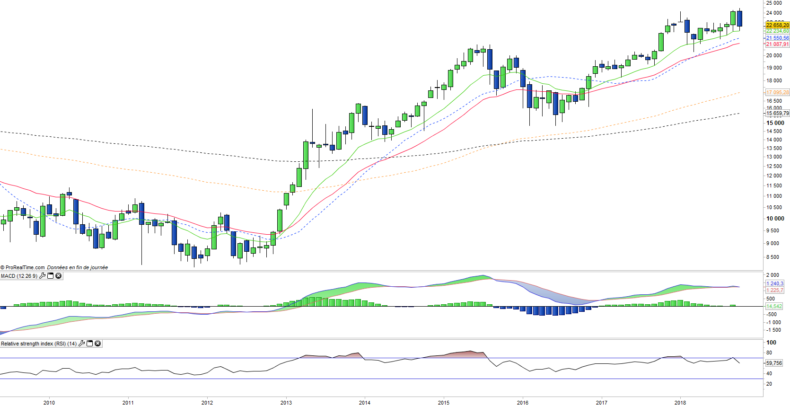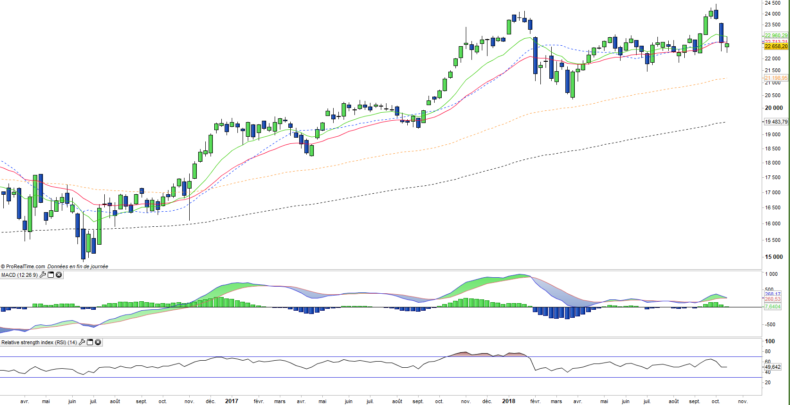Lyxor ETF Japan (Topix) - JPN - 19/10/2018
Short Term strategy: Negative (30%) / Trend -
Long Term strategy: Positive (80%) / Trend =
Characteristics of the ETF
The JPN ETF (Lyxor UCITS) created in 08/2006 is listed in euros on Euronext and replicates Topix Gross Total Return index which is composed of 2080 Japanese stocks, while each share is weighted according to its market capitalization. This index embeds a risk related to the evolution of the Euro / Yen pair linked to the economy and the policy of the central banks of the two zones.
The fee of this ETF is 0.45% for an AUM of € 1337M. The replication method is direct (physical) and there is a policy of semi-annual distribution of dividends.
Alternative ETFs: TPXH (Amundi in Euro), EWJ (iShares in USD), EJAH (BNP Paribas Easy in Euro)
Index & components
The Topix index is of a very great depth and the most representative of the Japanese economy.
The industry in all its forms (consumer goods, equipment, heavy industry ...) is strongly represented in the index (overall around 50%) with a financial sector that weighs 11.9% and a health sector to 7.7% while the technology sector is fairly large and accounts for 10.1% of the index. In the first 10 capitalizations, which represent about 16% of the Topix index, we will find automakers (Toyota, Honda), and groups such as Mitsubishi, Softbank and Sony as well as financials.
The cumulative performance of this ETF since January 2010 is around 109%, which also includes Yen / Euro currency movements (Topix performance over the period reach 124%).
The Japanese economy is the world's third largest, behind the US and China, with a GDP of about $ 5000 billion, it is a very diversified economy based on services and industry / advanced technology and whose model of growth is based on exports of consumer goods (automotive, technological goods) of capital goods and infrastructure, which is somewhat similar to that of Germany.
The Japanese economy is quite dependent on the evolution of its currency with the main world currencies (Dollar, Euro, Renminbi, Sterling), while the most important problem remains that of the deflation which lasts for two decades. This deflation first came from a time adjustment of the price of assets that had entered a bubble (1980s), but it is also due to a structural problem linked to the declining demography not offset by immigration.
Japan is today the most indebted country in the developed world but the national debt is held by the Japanese and not by foreign funds which limits the risk of financial crisis, but which, on the other hand, forces the economic recovery.
The reassuring news from China and the deepening of the economic partnership with India, however, are favorable factors while the current valuation of the Japanese index remains reasonable with a potential for high earnings growth.
Latest developments
After a rise of 6.6% in 2016, the performance of JPN accelerated in 2017 to + 10.7%.
The index has fallen -1.2% since the beginning of 2018, which is linked to the tensions related to the trade war initiated by D.Trump, which mainly concerns China but which could strongly affect Japan.
Japan's growth is associated with some relative Yen’s weakness, as the economy is based on exports. In addition, valuations of the index remain reasonable at around 16x earnings at 12 months for earnings growth expected between 7 and 10%. The evolution of the YEN / USD parity is quite stable but rather on the downside, which is a positive for the Japanese exporting companies.
Monthly data
The monthly chart shows a positive trend that has entered a lateral phase for about 1 year, but moving averages remain upwards which is a positive factor and favors an upward recovery. On the other hand the technical oscillators are turning down and time is playing against the trend. The October candlestick is patched as on most other places but does not represent any particular threat.
Weekly data
On the weekly chart, we can see a medium-term trend that remains bullish and framed by the major support that represents the EMA100. The EMA100 represents the pivotal point of the trend, and as long as the prices follow this support the trend remains bullish. However in case of bearish breakout, the fall could accelerate towards the EMA200.
ETF Objective
JPN is a UCITS ETF, listed in EUR, which seeks to replicate the Japan Topix index.
Characteristics
| Inception date | 10/11/2005 |
| Expense ratio | 0,45% |
| Issuer | Lyxor |
| Benchmark | indice TOPIX |
| code/ticker | JPN |
| ISIN | FR0010245514 |
| UCITS | Yes |
| EU-SD Status | Out of scope |
| Currency | EUR |
| Exchange | Euronext Paris |
| Assets Under Management | 1 382 M€ |
| PEA (France) | No |
| SRD (France) | Yes |
| Dividend | Distribution |
| Currency risk | Yes |
| Number of Holdings | 2097 |
| Risk | 3/5 |
Country Breakdown
| Japan | 100% |
Sector Breakdown
| Industrials | 22% |
| Consumer discretionary | 18% |
| Financials | 12% |
| Information technology | 10% |
| Consumer staples | 9% |
| Communication services | 8% |
| Health Care | 8% |
| Others | 14% |
Top Ten Holdings
| Toyota Motor | 3% |
| Mitsubishi Financial Group | 2% |
| Sony Corp | 2% |
| Softbank | 2% |
| Sumitomo Mitsui Financial | 1% |
| Nippon Telegraph | 1% |
| Honda Motor | 1% |
| Keyence Corp | 1% |
| KDDI | 1% |
| Mizuho Financial Group | 1% |


